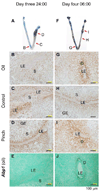Temporal expression pattern of progesterone receptor in the uterine luminal epithelium suggests its requirement during early events of implantation
- PMID: 21371703
- PMCID: PMC3080439
- DOI: 10.1016/j.fertnstert.2011.01.160
Temporal expression pattern of progesterone receptor in the uterine luminal epithelium suggests its requirement during early events of implantation
Abstract
Objective: To determine the precise timing of progesterone receptor (PR) disappearing from the uterine luminal epithelium (LE) to help understand the significance of the dynamic PR expression in the LE during embryo implantation.
Design: Experimental rodent models.
Setting: University research laboratories.
Animal(s): Mice and hamsters.
Intervention(s): Pseudopregnancy and artificial decidualization.
Main outcome measure(s): Blue dye injection for detecting embryo attachment; immunohistochemistry, immunofluorescence, and in situ hybridization for detecting gene expression.
Result(s): Progesterone receptor remained expressed in the LE up to 6 hours after the initial detection of blue dye reaction in mice (day 3, 22:00 hours), but disappeared first from LE cells at the implantation site and subsequently from the entire LE layer by day 4, 06:00 hours, when uterine stromal decidualization had become obvious. Progesterone receptor remained highly expressed in the LE of day 4 at 11:00 hours in pseudopregnant mice, but it disappeared from the entire LE layer by day 4 at 06:00 hours in artificially decidualized pseudopregnant mice.
Conclusion(s): Progesterone receptor disappears from the LE after implantation has initiated and before the histologic decidualization manifests, suggesting an active role of continued PR expression in the LE for the initial implantation process. The disappearance of PR expression in the LE is regulated by uterine factor(s) produced upon embryo attachment.
Published by Elsevier Inc.
Figures




Similar articles
-
Unique uterine localization and regulation may differentiate LPA3 from other lysophospholipid receptors for its role in embryo implantation.Fertil Steril. 2011 May;95(6):2107-13, 2113.e1-4. doi: 10.1016/j.fertnstert.2011.02.024. Epub 2011 Mar 15. Fertil Steril. 2011. PMID: 21411082 Free PMC article.
-
Studies using the estrogen receptor alpha knockout uterus demonstrate that implantation but not decidualization-associated signaling is estrogen dependent.Biol Reprod. 2002 Oct;67(4):1268-77. doi: 10.1095/biolreprod67.4.1268. Biol Reprod. 2002. PMID: 12297545
-
Broad gap junction blocker carbenoxolone disrupts uterine preparation for embryo implantation in mice.Biol Reprod. 2013 Aug 15;89(2):31. doi: 10.1095/biolreprod.113.110106. Print 2013 Aug. Biol Reprod. 2013. PMID: 23843229 Free PMC article.
-
In vivo analysis of progesterone receptor action in the uterus during embryo implantation.Semin Cell Dev Biol. 2008 Apr;19(2):178-86. doi: 10.1016/j.semcdb.2007.12.001. Epub 2008 Jan 6. Semin Cell Dev Biol. 2008. PMID: 18280760 Review.
-
Biology of progesterone action during pregnancy recognition and maintenance of pregnancy.Front Biosci. 2002 Sep 1;7:d1879-98. doi: 10.2741/spencer. Front Biosci. 2002. PMID: 12161340 Review.
Cited by
-
Multigenerational exposure to dietary zearalenone (ZEA), an estrogenic mycotoxin, affects puberty and reproduction in female mice.Reprod Toxicol. 2014 Aug;47:81-8. doi: 10.1016/j.reprotox.2014.06.005. Epub 2014 Jun 24. Reprod Toxicol. 2014. PMID: 24972337 Free PMC article.
-
Deletion of Lysophosphatidic Acid Receptor 3 (Lpar3) Disrupts Fine Local Balance of Progesterone and Estrogen Signaling in Mouse Uterus During Implantation.Biol Reprod. 2015 Nov;93(5):123. doi: 10.1095/biolreprod.115.131110. Epub 2015 Oct 7. Biol Reprod. 2015. PMID: 26447143 Free PMC article.
-
Unique uterine localization and regulation may differentiate LPA3 from other lysophospholipid receptors for its role in embryo implantation.Fertil Steril. 2011 May;95(6):2107-13, 2113.e1-4. doi: 10.1016/j.fertnstert.2011.02.024. Epub 2011 Mar 15. Fertil Steril. 2011. PMID: 21411082 Free PMC article.
-
Olfactomedin 1 Deficiency Leads to Defective Olfaction and Impaired Female Fertility.Endocrinology. 2015 Sep;156(9):3344-57. doi: 10.1210/en.2015-1389. Epub 2015 Jun 24. Endocrinology. 2015. PMID: 26107991 Free PMC article.
-
11-deoxy prostaglandin F(2α), a thromboxane A2 receptor agonist, partially alleviates embryo crowding in Lpar3((-/-)) females.Fertil Steril. 2012 Mar;97(3):757-63. doi: 10.1016/j.fertnstert.2011.12.004. Epub 2012 Jan 4. Fertil Steril. 2012. PMID: 22222195 Free PMC article.
References
-
- Cheon YP, Li Q, Xu X, DeMayo FJ, Bagchi IC, Bagchi MK. A genomic approach to identify novel progesterone receptor regulated pathways in the uterus during implantation. Mol Endocrinol. 2002;16:2853–2871. - PubMed
-
- Bazer FW, Slayden OD. Progesterone-induced gene expression in uterine epithelia: a myth perpetuated by conventional wisdom. Biol Reprod. 2008;79:1008–1009. - PubMed
-
- Wang H, Dey SK. Roadmap to embryo implantation: clues from mouse models. Nat Rev Genet. 2006;7:185–199. - PubMed
-
- Mulac-Jericevic B, Conneely OM. Reproductive tissue selective actions of progesterone receptors. Reproduction. 2004;128:139–146. - PubMed
Publication types
MeSH terms
Substances
Grants and funding
LinkOut - more resources
Full Text Sources
Research Materials

